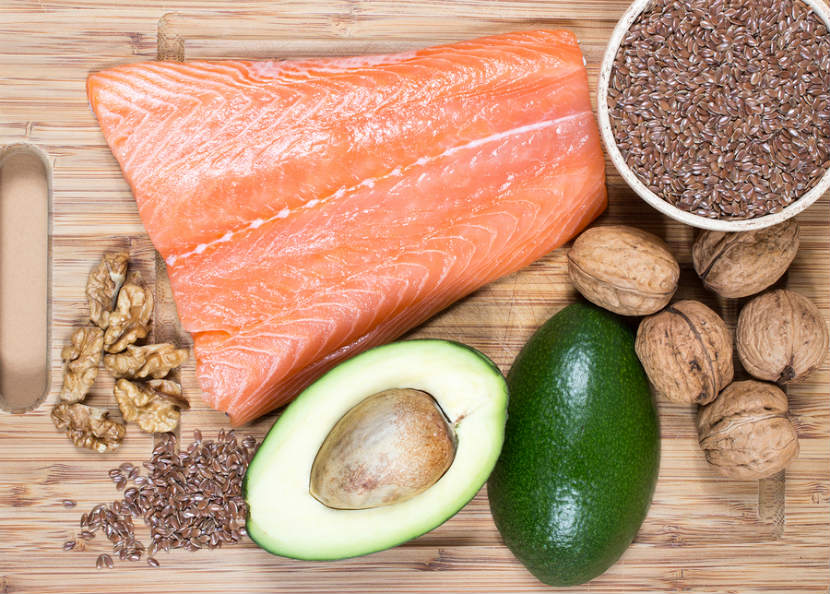
You have probably heard a lot about omega-3 fats. Omega-3 fats are healthy fats with many health benefits. Read on to learn more about what foods have omega-3 fats and how to add them to your diet.
What are the health benefits of omega-3 fats?
Omega-3 fats are healthy fats with many health benefits for adult and children. Omega-3 fats may help lower your risk of heart disease. In infants, omega-3 fats help with brain, nerve and eye development. Research is currently being done to see if omega-3 fats play a role in lowering the risk of cancer, dementia, Alzheimer’s disease and depression.
The three types of omega-3 fats are:
-
ALA (alpha-linolenic acid)
-
EPA (eicosapentaenoic acid)
-
DHA (docosahexaenoic acid)
All three types of omega-3 fats are important to have in your diet.
Tips for getting EPA and DHA
EPA and DHA are found in fatty fish like salmon, mackerel, anchovies, sardines, herring, Arctic Char and trout. Try the tips below:
-
Grill salmon for an easy and fast meal. Use a low sodium sauce, orange-ginger or lemon-dill for seasoning. Try Tea Poached Salmon with Fruit Salsa.
-
Use baked rainbow trout to make a wrap with romaine lettuce, grated cheese and a little mayonnaise.
-
Use canned salmon to make a quick salmon quiche for dinner. Remember to mash the bones.
-
Try a twist on tuna salad. Add sliced grapes, diced apples and walnuts for extra crunch.
-
Broil herring with lemon and garlic.
-
Use anchovies or sardines as pizza toppings.
-
Try canned sardines as a snack with crackers.
How much fish should I eat to get the health benefits of omega-3 fats?
Canada’s Food Guide recommends you eat at least two Food Guide servings of fish per week. One serving is equal to 75 grams (2 ½ ounces) or half a cup of cooked fish. Choose fatty fish which are higher in omega-3 fats more often.
Tips for getting ALA
ALA is found in foods like flax seeds, walnuts, soy products and omega-3 enriched products like eggs, milk and margarine. Very little of the omega-3 fat is absorbed from flax seeds because the seed is very hard to digest by the body. The body can absorb the omega-3 when the flaxseed is ground. Omega-3 fats are also found in vegetable oils like flax seed, canola and soybean oils.
Try the tips below:
-
Add ground flaxseeds to cereal, oatmeal and yogurt or add it to baked goods.
-
Add soybeans or tofu to stir fry dishes. Try Tofu Vegetable Soup or Sweet Chilli Tofu Stir-Fry.
-
Add walnuts to yogurt, salads or baked goods.
-
Replace regular eggs with omega-3 eggs. Make Stove-Top Broccoli and Mushroom Quiche with omega-3 eggs.
-
Use non-hydrogenated margarine made from canola or soybean oil on toast or when cooking or baking.
-
Use flaxseed, canola or soybean oil on salads or when cooking or baking.
Be mindful of how much vegetable oil and non-hydrogenated margarine you use. Health Canada recommends a total of 2 to 3 tablespoons of healthy fats per day.
Fish and mercury facts
Eating fatty fish provides many health benefits. However, children and women who are pregnant, breastfeeding or may become pregnant should limit certain types of fish due to the higher levels of mercury that may be present. To learn more about fish and mercury, read Get the real scoop on fish and mercury.
Do other foods contain omega-3 fats?
Some foods in the grocery store now have added omega-3 fats. The amount of omega-3 fats in these foods varies. Including a variety of foods with added omega-3 fats will help increase your intake. However, fatty fish is the best source of omega-3 fats in your diet. Look for the words “omega-3,” “ALA,” “EPA,” or “DHA” on nutrition labels of foods like:
-
Eggs*
-
Margarine
-
Cow’s milk
-
Yogurt
-
Soy beverage
-
Bread
-
Cereal
*Note: If you have high cholesterol, diabetes or heart disease, there is a maximum number of egg yolks you should have each week even if they are omega-3 eggs.
Should I take an omega-3 supplement?
If you are a vegetarian, vegan or simply don’t like the taste of fish, you may benefit from an omega-3 supplement. Some supplements are made from algae oil and some from fish oil. The quality and amount of omega-3 fats in these supplements can vary widely. Look for supplements that have a Natural Product Number (NPN). The NPN ensures that the product has met the standards for quality, safety and efficacy set by Health Canada for Natural Health Products. The quality requirements include testing for chemical impurities such as heavy metals, pesticides and known contaminants.
Speak to your health care professional before starting an omega-3 supplement. Your health professional will recommend the amount and type of omega-3 supplement that is right for you.
Bottom line
Omega-3 fats may offer many health benefits including lowering the risk of heart disease and some cancers. Get all the health benefits of omega-3 fats by eating at least two Food Guide Servings of fish per week and adding omega-3 rich foods to your diet.
Speak to your health care professional if you are considering an omega-3 supplement. A health care professional can recommend the type and amount of omega-3 supplement that is right for you.
You may also be interested in:
Fish oil basics
Get the reel scoop on fish and mercury
Consumption Advice: Making Informed Choices about Fish, by Health Canada
Mercury your health and the environment, by Health Canada
Last Update – January 29, 2019